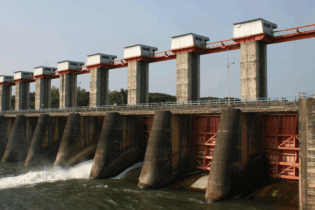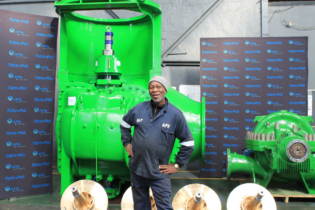It is with exasperation that the South African Institution of Civil Engineering (SAICE) learnt of Minister Edna Molewa of Water and Environmental Affairs’ signing of an agreement with her Cuban counterpart to pave the way for 34 Cuban engineers to “sort out our water crisis while here for a two-year stint”.
Just to put the concern into perspective, the TimesLIVE wrote, “Cuba has massive water problems. According to the Canadian International Development Research Centre, its water and sanitation services have deteriorated badly, resulting in an increase in water-borne diseases.” South Africa has world-class civil engineering professionals in the water sector. Should the Department of Water Affairs (DWA) have launched their “recruitment drive to find skilled professionals to deal with South Africa’s water problems” in South Africa, SAICE is confident that many a civil engineering practitioner, who knows South Africa’s water challenges inside out, would have been available to assist in ‘sorting’ these out. Dr Martin van Veelen, 2012 president of SAICE, stated, “South Africa is blessed with a highly competent and experienced corps of engineering practitioners. It is one of the few countries on the African continent that does not need consultants from Europe or other countries to solve the challenges of a developing country. However, the centre of gravity of the accumulated wisdom lies in an ageing, predominantly white and male group of professionals. This is certainly not politically correct, but it is a fact. The country cannot afford to disregard this boon if the objectives of the National Development Plan (NDP) are to be achieved.” Unfortunately this experience, expertise and wisdom will only be available to South Africa for the next five to seven years before they really have to retire or worse. Manglin Pillay, CEO of SAICE, states, “Our engineers need to get first choice. We have excellent engineers both locally as well as those who are currently working outside of South Africa, because the political climate is against them. They are too white and it is being perceived more and more that white professionals are unwelcome in South Africa. This is the impression that government is creating – albeit it only an impression. Government needs to make strides to attract South African engineers back to South Africa and back into our government sector where they are most needed. If there is a shortage thereafter, then the whole world can join us.” One cannot blame civil engineering practitioners if they start feeling alienated by the very government that will not be able to answer to the NDP goals without them, as they are essential to any infrastructure development in future. What makes it even worse is that the department’s spokesperson, Themba Khumalo, said that this agreement was one of many to be signed with a number of countries in a bid to deal with the water crisis. He further contends that the Cubans will play an important role because South African engineers and hydrologists did not want to work in rural areas. Is that perhaps because South African engineers would not be able to live on what they would be paid, and the Cubans can? Furthermore, Khumalo asserts that the Cuban engineers will be deployed in rural and disadvantaged areas to:- Provide geo-hydrology and engineering services
- Assist in exploitation of water resources
- Maintain water-supply infrastructure
- Help with capacity building through training and support of local staff
- Manage water supply
b) The opportunity cost is the lack of development of a local engineer.
c) Often properties that are rented are not occupied for months because of ‘administration failure’, but the rental amount is paid anyway. OR – a single engineer/person gets to live in a 5-bedroom unit, etc. So there is hint of inappropriate spending.” In 2002, 25 infrastructure professionals were brought into South Africa, with a further 400 Cuban professionals in architecture, engineering and medicine arriving in 2010. From an engineering perspective, the Cuban engineers were involved strictly on housing development projects as advisors and on-site supervisors. Some of these indicated that they were indeed placed in jobs, but that language was a huge barrier which prevented them from doing meaningful work. During their second year they could start assisting in doing some work,but then they had to leave for Cuba. This just does not make sense. Mava Scott, spokesperson of the DWA in a statement in September 2013, said, “Post the lapse of the Agreement and at the end of the experts’ secondment a needs analysis was conducted to determine the need for further engagement with and secondment of more Cuban expertise within the Department. This analysis reflected an appreciation of the Cuban expertise and therefore a re-negotiation process of the Agreement was undertaken and concluded in March 2013.” One has to wonder by whom this analysis was done! She furthermore stated, “… that the work of the Cuban experts will greatly enhance the capacity of the Department as it seeks to carry out its Constitutional mandate as well as deliver on the expectations of the people of South Africa. Water being a catalyst for all socio-economic development is central to the betterment of the lives of all South Africans.” SAICE interventions SAICE through its ENERGYS programme,teamed retired engineers with 3 or 4 students needing experiential training (university of technology students) and a young graduate engineer (university – BSc Eng qualification) and sent them to local authorities that were facing challenges in engineering service delivery. This mechanism provided the municipalities with adequate capacity to ensure project roll out, and also provided opportunities for the training of students. Under this ENERGYS programme, R9bn worth of projects wererolled out in the Gauteng Province. This is the kind of project that should be replicated across the country to ensure knowledge transfer and practical mentorship. Furthermore, SAICE published its first Infrastructure Report Card (IRC) for South Africa in 2006; a second edition was published in 2011. The IRC is a barometer of the status of infrastructure at any given time. In 2006, SAICE met with various infrastructure ministers to share the findings of the report card. In 2011, government departments were also invited to engage on the findings of the 2011 IRC. It was at these events that the challenge of unemployment, lack of systems and structures and the urgent need for capacity at national, provincial and local department levels were discussed. The National Development Plan, together with President Zuma’s State of the Nation Address and Minister Pravin Gordhan’s Budget Speech, placed emphasis on job creation, and infrastructure development. This affords SAICE the opportunity to engage with government, and to serve as the honest and non-biased broker for civil engineering expertise to be installed back into the system. “It must be noted that there is immense confusion on who to approach if one has to deal with these issues. The possibilities include approaching individual infrastructure department like the national Departments of Transport, Water Affairs, Public Works, Housing, Corporate Governance and Traditional Affairs. Very often once communication has been established, Ministers, DGs and/or DDGs change quickly under various circumstances. Continuity is thus prevented and the process of establishing contact and relationships needs to start all over again.” Furthermore, Pillaysays, “It appears the weakness in government structures is the lack of knowledge on how to identify projects and how to spend the allocated money. This is evident from the lack of structures, processes and systems in government to manage infrastructure spend. Then there is the cauldron of unsuitably qualified individuals, ineffectually occupying technical engineering posts, nervously managing engineering projects, and second-guessing the allocation of funds. It is necessary tore-install appropriately qualified and professionally registered technical people back into the system to plan, identify, procure and manage large-spend engineering projects.” Approaching government raises the challenge that when engineers,and particularly business owners, raise these concerns, there exists the fear of being marginalised from further project work with government. SAICE has, however, been raising these concerns on behalf of its members (individual civil engineers) and continues to offer assistance to government to resolve these key challenges. Bringing Cuban engineers to South Africa will not solve government’s lack of communication with the civil engineering fraternity to solve the water problems. These issues could be discussed at the Civilution Congress to be hosted by SAICE from 6 to 8 April 2014, but that may be too late. Peter Kleynhans, 2013 president of SAICE, remarks, “Above all we must realise that we need one another; one party cannot perform without the other. We must act as a unified team, with one single common goal – a better and more prosperous country for all.” SAICE is seriously concerned about importing Cuban engineers and implores government, and specifically the Department of Water Affairs, to engage with them to find solutions to these. Let’s stand together and find solutions to our own problemstomake a difference.







